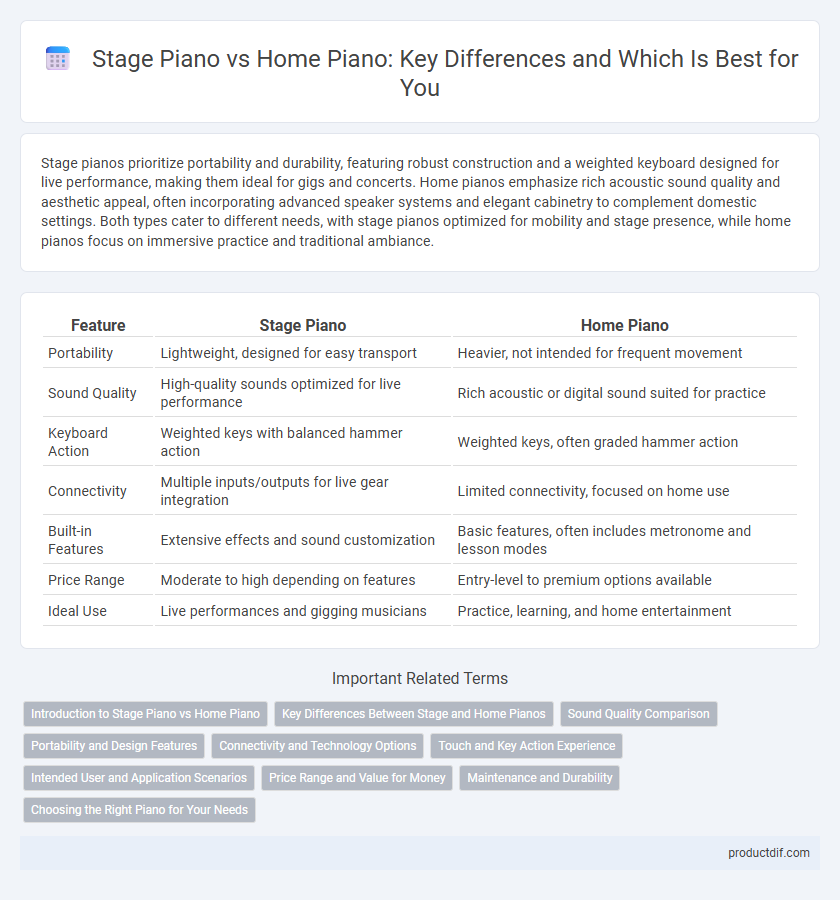Stage pianos prioritize portability and durability, featuring robust construction and a weighted keyboard designed for live performance, making them ideal for gigs and concerts. Home pianos emphasize rich acoustic sound quality and aesthetic appeal, often incorporating advanced speaker systems and elegant cabinetry to complement domestic settings. Both types cater to different needs, with stage pianos optimized for mobility and stage presence, while home pianos focus on immersive practice and traditional ambiance.
Table of Comparison
| Feature | Stage Piano | Home Piano |
|---|---|---|
| Portability | Lightweight, designed for easy transport | Heavier, not intended for frequent movement |
| Sound Quality | High-quality sounds optimized for live performance | Rich acoustic or digital sound suited for practice |
| Keyboard Action | Weighted keys with balanced hammer action | Weighted keys, often graded hammer action |
| Connectivity | Multiple inputs/outputs for live gear integration | Limited connectivity, focused on home use |
| Built-in Features | Extensive effects and sound customization | Basic features, often includes metronome and lesson modes |
| Price Range | Moderate to high depending on features | Entry-level to premium options available |
| Ideal Use | Live performances and gigging musicians | Practice, learning, and home entertainment |
Introduction to Stage Piano vs Home Piano
Stage pianos are designed for live performances, featuring durable build quality, weighted keys, and a variety of built-in sounds optimized for on-stage versatility. Home pianos, including digital and acoustic models, prioritize a more traditional playing experience and often focus on sound authenticity and comfort for practice or casual play. While stage pianos emphasize portability and connectivity options for professional settings, home pianos cater to users seeking a balance between realistic touch and sound in a controlled environment.
Key Differences Between Stage and Home Pianos
Stage pianos prioritize portability, featuring weighted keys and robust sound engines designed for live performance settings, while home pianos emphasize acoustic quality and rich tonal depth suitable for practice and intimate environments. Stage pianos often include multiple connectivity options such as MIDI and USB, enabling integration with various audio equipment, whereas home pianos typically focus on simplicity and traditional digital piano features. The key difference lies in the balance between durability and functionality tailored for stage use versus the nuanced sound and feel preferred for home playing.
Sound Quality Comparison
Stage pianos deliver superior sound quality with advanced sampling technology and powerful onboard speakers designed for live performance dynamics. Home pianos prioritize realistic acoustic tone replication and nuanced key action to provide an authentic playing experience in controlled environments. Sound quality in stage pianos emphasizes projection and clarity in large venues, while home pianos focus on detailed sound fidelity suited for intimate settings.
Portability and Design Features
Stage pianos are designed with portability in mind, featuring lightweight chassis and rugged build quality that withstand frequent transport and live performances. In contrast, home pianos prioritize aesthetic appeal and often have bulkier frames or cabinetry that enhance room decor but limit mobility. Both types integrate advanced digital sound engines, yet stage pianos usually offer more accessible controls and connectivity options tailored for professional gigging musicians.
Connectivity and Technology Options
Stage pianos offer extensive connectivity options such as MIDI ports, USB interfaces, and multiple audio outputs, enabling seamless integration with professional audio equipment and digital workstations. Home pianos typically focus on built-in features like Bluetooth for wireless audio streaming and headphone jacks for private practice, prioritizing convenience over complex connectivity. Advanced stage pianos often include customizable control panels and software compatibility, allowing musicians to tailor their setup for live performance or studio production.
Touch and Key Action Experience
Stage pianos offer weighted hammer-action keys designed to replicate the feel of an acoustic grand piano, providing a highly responsive and dynamic touch ideal for live performances. Home pianos often feature semi-weighted or synth-action keys that are lighter and less expressive, prioritizing convenience and portability over authentic key resistance. The key action experience on stage pianos enhances control over dynamics and articulation, making them preferred by professional musicians seeking realistic finger response.
Intended User and Application Scenarios
Stage pianos cater to professional musicians and performers, offering robust sound projection, extensive connectivity options, and durability for live concerts and tours. Home pianos, designed for casual players and hobbyists, emphasize compact size, user-friendly interfaces, and integrated learning features suited for practice, composition, and family entertainment. Choosing between stage and home pianos depends on the intended user's performance needs, space availability, and specific usage environments.
Price Range and Value for Money
Stage pianos typically range from $1,000 to $3,500, offering robust sound engines and durability designed for live performances, making them a valuable investment for gigging musicians. Home pianos, priced between $500 and $2,000, prioritize affordability and user-friendly features suitable for practice and casual playing, providing excellent value for beginners and hobbyists. Choosing between the two depends on balancing budget constraints with desired functionalities and performance needs.
Maintenance and Durability
Stage pianos are built with rugged materials and robust construction to withstand frequent transport and heavy use, requiring less frequent maintenance compared to home pianos. Home pianos, often designed for stationary use, demand regular tuning and care to maintain sound quality and mechanical function due to exposure to indoor environmental factors. Both types benefit from periodic inspections, but stage pianos prioritize durability and resilience under varied conditions.
Choosing the Right Piano for Your Needs
Selecting between a stage piano and a home piano depends on your performance environment and functional requirements. Stage pianos offer portability, extensive sound options, and robust durability ideal for live gigs and studio work, while home pianos emphasize authentic acoustic sound, aesthetic appeal, and often include weighted keys to simulate traditional piano touch experience. Consider factors such as space, budget, desired sound quality, and intended usage to determine the best fit for your musical practice and performance needs.
Stage piano vs Home piano Infographic

 productdif.com
productdif.com